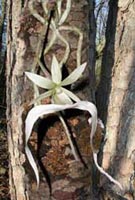Resource Library
Plant of the Week: Orchid, Ghost
The University of Arkansas System Division of Agriculture does not promote, support or recommend plants featured in "Plant of the Week." Please consult your local Extension office for plants suitable for your region.
Plant of the Week
Ghost Orchid
Latin: Polyrrhiza lindenii

Loved the book, hated the movie. In writing these columns about plants I seldom get the opportunity to do a book review, let alone a movie review. But, when the opportunity presented itself how could I let it pass. A central character in both is the ghost orchid (Polyrrhiza lindenii)that is indigenous to only one place in the world, the 84,000 acre Fakahatchee Strand State Preserve in southern Florida.
Like most orchids the ghost orchid has beautiful flowers but is an ugly plant. The solitary white flower is borne on an arching 8-inch peduncle. The bloom itself is a 6-inch affair with more or less normal orchid pedal arrangement but with its lower lip producing two long, slightly twisted petals that extend downward and look like a Fu Man Chu mustache.
The plant itself isn’t there. It’s a ghost. Orchids tend to be a bit on the bizarre side anyway, but for a plant to grow without any foliage is pushing the limits of believability. The plant itself consists of just a few cord-like roots that creep across the bark of a supporting tree trunk, forming a spider-like cluster about eight inches across. What photosynthesis occurs goes on inside the fleshy roots.
The ghost orchid would no doubt have remained in botanical obscurity, known only to a the most fanatic orchid collectors, were it not for Susan Orlean’s fine 1998 book The Orchid Thief. The book grew out of her adventures and discoveries as she covered the trial of John Laroche, a Florida man charged along with three Seminole Indians, for stealing ghost orchids from the Fakahatchee Strand.
The book is an excellent read for it showcases how a plant novice explores the quirky world of orchid collecting and the gentle madness that make serious plant people unique among the species of common man. Like many plant-collecting fanatics, Laroche seems afflicted with the obsessive-compulsive disorder that both attracts and repels fellow plant lovers.
But if you got a book, it goes without saying that your agent will try to pitch the story to Hollywood. But, how can you make a movie about quirky plant people and an exotic orchid into a movie when it has no sex or violence? Simple. You tell a completely different story that has no connection whatsoever with the book.
The movie, Adaptation, tries to tell the story from the perspective of a struggling screen writer (Nicholas Cage) trying to adapt a book about an orchid into a movie. To do this - and I know this sounds too preposterous to be true - they add the Hollywood magic of sex, man-eating alligators, and murder. While Meryl Streep and Chris Cooper do a good job portraying Orlean and Laroche, the adaptation of Orchid Thief for the movie Adaptation falls flat - with little enlightenment and less entertainment.
The ghost orchid is in cultivation, thanks in no small measure to orchid people like Laroche who illegally collected plants from the wild and propagated them using tissue culture. Cultivating rare and endangered plants, and increasing their numbers far beyond what would ever occur in nature presents a conundrum for conservationists. What is really threatened is the unique habitat of the swamp, and the ghost orchid is but one member of that complex community. The argument for maintaining rare and unique ecological areas in a pristine manner loses some of its punch when you demonstrate that the plant can be grown in other, far different conditions.
One final note. Those of you able to view the illustration accompanying this article are also looking at a ghost. The orchid is not real, but an artificial orchid created by one of our former students, Tom Wu from Taiwan. Tom’s mother taught him the art of modeling flowers, mainly from paper machete, when he was a 5-year-old and laid up with a leg problem. His master’s of science thesis involved orchid tissue culture, but today he is the artist designing artificial flowers for a Chinese factory that exports them to the West.
By: Gerald Klingaman, retired
Extension Horticulturist - Ornamentals
Extension News - February 21, 2003
The University of Arkansas System Division of Agriculture does not maintain lists of retail outlets where these plants can be purchased. Please check your local nursery or other retail outlets to ask about the availability of these plants for your growing area.